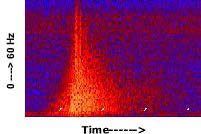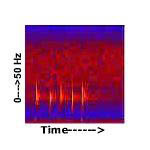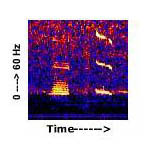
![]() This diagram, called a spectrogram, shows the acoustic signal of an earthquake located near Astoria Canyon as recorded on a SOSUS hydrophone. Click image to listen to the earthquake (QuickTime, 44k).
This diagram, called a spectrogram, shows the acoustic signal of an earthquake located near Astoria Canyon as recorded on a SOSUS hydrophone. Click image to listen to the earthquake (QuickTime, 44k).
Hydroacoustics
Robert Dziak
Seismologist
NOAA, Pacific Marine Environmental Laboratory
Sharon Nieukirk
Marine Mammal Biologist
NOAA, Pacific Marine Environmental Laboratory
Sound in the Deep Sea
Hydroacoustics is the study of sound in water. Because of the physical properties of the ocean, light waves can only travel a few feet in water before their energy is absorbed. Sound waves, on the other hand, travel great distances underwater without losing strength, making sound a very effective method for observing geological and biological phenomena in the ocean. Scientists use a series of underwater microphones (called hydrophones) to listen in on these natural phenomena and find out where in the ocean they occur.
Hydroacoustic monitoring (listening to underwater sounds) of the North Pacific Ocean has revealed the region to be dynamic and constantly evolving in terms of both geologic and biologic activity. Monitoring ocean sounds has allowed us to listen in on the movement of magma through the sea floor during three major volcanic eruptions; observe large-scale faults shattering the ocean crust; monitor sea-floor geysers as they change their eruption pattern in response to these sea-floor upheavals; and establish the geographic variation and distribution of the calls of huge whales in the North Pacific. Astoria Canyon, located in the northeastern corner of the region, has been shown to be an acoustically lively area, exhibiting earthquakes and whales calls almost continuously during the last 10 years.


![]() The call of the fin whale (above) is a short, pulsive call typically centered at about 20 Hertz . The streamlined shape (below) of the fin whale allows it to swim at speeds greater than 20 mph. Click images for a larger view and to listen to a fin whale (QuickTime, 32k).
The call of the fin whale (above) is a short, pulsive call typically centered at about 20 Hertz . The streamlined shape (below) of the fin whale allows it to swim at speeds greater than 20 mph. Click images for a larger view and to listen to a fin whale (QuickTime, 32k).
Listening to the North Pacific Ocean
Since 1991, the NOAA Vents Program has performed hydroacoustic monitoring of the north Pacific Ocean using a set of U.S. Navy hydrophones called the Sound Surveillance System (SOSUS). These hydrophones rest directly on the sea floor at several locations throughout the North Pacific, and are essential for studying the frequency characteristics of the recorded sound signals. Frequency is the amount of time it takes for successive peaks of a sound wave to pass by an observation point, and is measured in units of cycles per second, commonly referred to as Hertz (Hz). It is the frequency and timing of a signal that gives a sound its particular characteristics. People can generally hear sound waves with frequencies between 20 and 20,000 Hz. Below 20 Hz, sounds are referred to as infrasonic, and above 20,000 Hz, as ultrasonic. With SOSUS, we have recorded the very low-frequency, infrasonic signals of earthquakes, submarine landslides, and the calls of blue whales and fin whales, as well as the audible sounds of passing ships and the background rumble of passing storm systems.
As part of the northeastern Pacific Ocean, the Astoria Canyon has also been continuously monitored for natural sounds during the past 10 years. During this time, we have detected a large amount of earthquake activity. The Astoria Canyon sits atop a geologic area called the Cascadia Subduction Zone. Here, one of the Earth's great tectonic plates, the Juan de Fuca, is being pushed beneath another great plate, that of North America. Typically, subduction zones produce vast amounts of earthquakes, and although the Astoria Canyon is located on a relatively quiet subduction zone, it is still an area of great natural mayhem. A total of 79 earthquakes have occurred in and around Astoria Canyon in the past 10 years, showing it to be a place of tremendous geological turmoil. Also, previous maps of the canyon indicate that it experienced several submarine landslides in the recent geologic past, which undoubtedly wreaked havoc on its fragile ecosystem. We have yet to definitively record one of these sea-floor maelstroms from Astoria Canyon on our hydrophones, but maybe we will soon. (Read more on the geology of Astoria Canyon.)


![]() Spectrogram of a northeast Pacific blue-whale call (above). The calls of this whale species are perhaps the best known to date. They generally consist of two parts, A and B. The A call is a series of pulses (on the order of 1.5 pulses/sec), while the B call is a long moan. The blue or "sulphur-bottomed" whale (below), is so named for its blue-gray coloration . Click images for a larger view and to listen to a blue whale (QuickTime, 48k).
Spectrogram of a northeast Pacific blue-whale call (above). The calls of this whale species are perhaps the best known to date. They generally consist of two parts, A and B. The A call is a series of pulses (on the order of 1.5 pulses/sec), while the B call is a long moan. The blue or "sulphur-bottomed" whale (below), is so named for its blue-gray coloration . Click images for a larger view and to listen to a blue whale (QuickTime, 48k).
'Thank providence for directing the whale to us'
Astoria Canyon also lies within the migratory corridor for many species of whales, including the blue whale and fin whale. Until recently, blue and fin whales were not thought to be common inhabitants of offshore Oregon waters. Acoustic evidence has revealed, however, that they are indeed here in fairly large numbers, but stay far offshore in waters not commonly monitored by conventional aerial and ship-based surveys. The blue whale is the largest whale ever to have lived, reaching over 100 ft in length, while fin whales are the second largest of the great whales, and can grow up to 70 ft long. Blue-whale vocalizations are very loud, low-frequency, two-part "moans" that are below our threshold of hearing. Fin-whale calls are also loud and infrasonic, but instead of a moan, fin whales produce a series of very short pulses. SOSUS hydrophones typically record the calls of both blue and fin whales during the late summer, fall and early winter months.
Although we frequently record blue-whale calls in our offshore waters, they are rarely spotted along the coast. There is a report, however, of what was likely a stranded blue whale in the journal of Meriwhether Lewis and William Clark. A day or two after Christmas 1806, members of the Chinook tribe informed Lewis and Clark that a whale had died on the ocean beach southwest of Fort Clatsop along the Columbia River. Clark successfully bargained with the local natives for about 300 pounds of whale blubber and a few gallons of oil from the stranded whale. He later wrote in his journal:
"Small as this Stock is I prise it highly . . . and thank providence for directing the whale to us; and think him much more kind to us than he was to jonah, having Sent this monster to be Swallowed by us in Sted of Swallowing of us as jonah's did."
Judging from the skeleton's length, estimated at 105 ft according to Clark's journal, it was probably that of a blue whale, making this the first recorded account of the stranding of a blue whale in North America.
Sign up for the Ocean Explorer E-mail Update List.





























